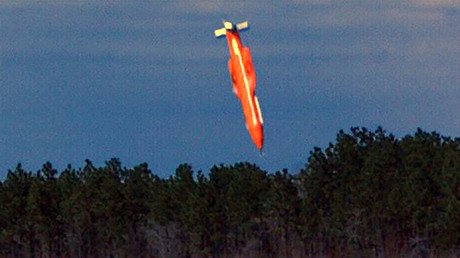‘They attacked civilians, they are not heroes’: Journalist recounts trampling by Venezuela defectors
In one of the most violent incidents in a day full of them, camerawoman Nicole Kramm was inches away from two hijacked army vehicles as they sped through a crowded border crossing between Venezuela and Colombia.
The three men inside were among the multiple military personnel who defected from the government side on Saturday.
This video filmed by Chilean journalist Nicole Kramm shows the moment she was injured as Venezuelan opposition supporters rammed armoured vehicles through the border with Colombia. Nicole has been working for redfish in #Venezuela. pic.twitter.com/hBlp2vE4h3
— redfish (@redfishstream) February 24, 2019
In the Western media they were treated as courageous augurs of the imminent collapse of the Nicolas Maduro regime. To Kramm, who is Chilean, they are anything but.
This was an attack on civilians. I can’t believe they are being treated as heroes. If I didn’t run, and was 15 centimetres closer, I would not be here to tell you this
Kramm said this from the hospital hours after her ordeal, in an interview posted on Twitter.
Ahead of the weekend, Western opposition backers knowingly added fuel to an already intense internal standoff in the South American state with their promise to deliver unsolicited humanitarian aid at the Colombian border.
VIDEO: Watch as three Venezuelan troops use their jeep to smash through a security barrier, on the Simon Bolivar bridge, as they desert to neighbouring Colombia pic.twitter.com/xNpbIv0yYo
— AFP news agency (@AFP) February 23, 2019
They knew that Caracas would not open the border to let in the trucks, for what they called a stunt, provocation, or worse, an attempt to smuggle weapons into the country.
The Simon Bolivar Bridge near the town of Urena on the Venezuelan side was one of three proximate crossings through which the transports were reported to be heading.
Also on rt.com Horrifying VIDEOS show RAMMING at Simon Bolivar bridge in VenezuelaFrom Saturday morning, hundreds gathered at the flashpoint – Colombian and Venezuelan troops, opposition and pro-government activists.
Also journalists, among them Kramm, who is a freelancer covering the conflict for RT’s project Redfish, and Mexican media.
Ahora | Relato de la fotoperiodista chilena Nicole Kramm, joven herida en la frontera entre Venezuela/Colombia.Fue impactada por 2 tanquetas con 4 desertores en su interior pic.twitter.com/6XXdV3nFsw
— PIENSA.PRENSA (@PiensaPrensa) February 23, 2019
She had seen slogans shouted, abortive attempts to penetrate the cordon, police lining up in formation, and tear gas deployed.
But the most terrifying moment is captured on camera, when two white “tanquetas” covering most of the width of the two-lane road suddenly hurtle without slowing towards the checkpoint.
In front of them the crowd – supporters, opponents and bystanders – scatter as best they can, pressing into the barriers around the road.
In the next snippet of video, a victim emerges screaming, face covered in blood. Kramm’s own pained expression is seen in another glimpse of the shaky footage as panic breaks out, and people clamber over the barricades to escape.
She was taken to hospital with a concussion and a leg injury.
“I got scared and cried because I could not feel my legs,” she wrote on Facebook on Sunday. “But the pain passes, and I love you, and feel your affection.”
She told her employers she plans to return to work as soon as she can.
Meanwhile, the men who nearly killed her got out and calmly walked to the other side, holding their weapons aloft, and were warmly welcomed by the Colombians. Opposition leader Juan Guaido, near the same border, said they must not be “treated as deserters, but those who put themselves on the side of the people and the constitution.”
But for all his lofty words, they do not conceal that according to the government almost as many people as 300 were injured in Venezuela on Saturday alone. As the conflict only gathers in intensity, what becomes less clear is the human cost of revolutionary aspirations, and who will pay it.
Subscribe to RT newsletter to get stories the mainstream media won’t tell you.














